Originally published on September 7, 2022
America's grid is in decline and about to get far worse due to policies that 1) reward unreliable electricity, 2) prematurely shut down coal plants, 3) criminalize nuclear, and 4) force electric vehicle use.
Here’s what’s happening and how to fix it.
-
A reliable grid is a foundation of our quality of life. Our lives depend on ultra-reliable electricity for the refrigerators that preserve our food, the water treatment plants that keep our water drinkable, the air conditioning that keeps us cool, the factories that produce our goods, etc.
-
Ominously, our grid is in an increasingly fragile state. Not only have we recently had statewide blackouts in California (2020) and Texas (2021), this summer shortages are occurring all around the US.
Federal Energy Regulatory Commission Commissioner Mark Christie puts it bluntly “We’re heading for a reliability crisis.”1
-
The root cause of our grid’s reliability problems is simple: America is shutting down too many reliable power plants—plants that can be controlled to produce electricity when needed in the exact quantity needed. And it is attempting to replace them with unreliable solar and wind.
-
Since at any given time solar and wind can go near zero, using them as replacements for reliable power plants doesn’t work. For example, Texas’s February 2021 disaster was caused by solar/wind disappearing and inadequate investment in reliable power plants and their weatherization.2
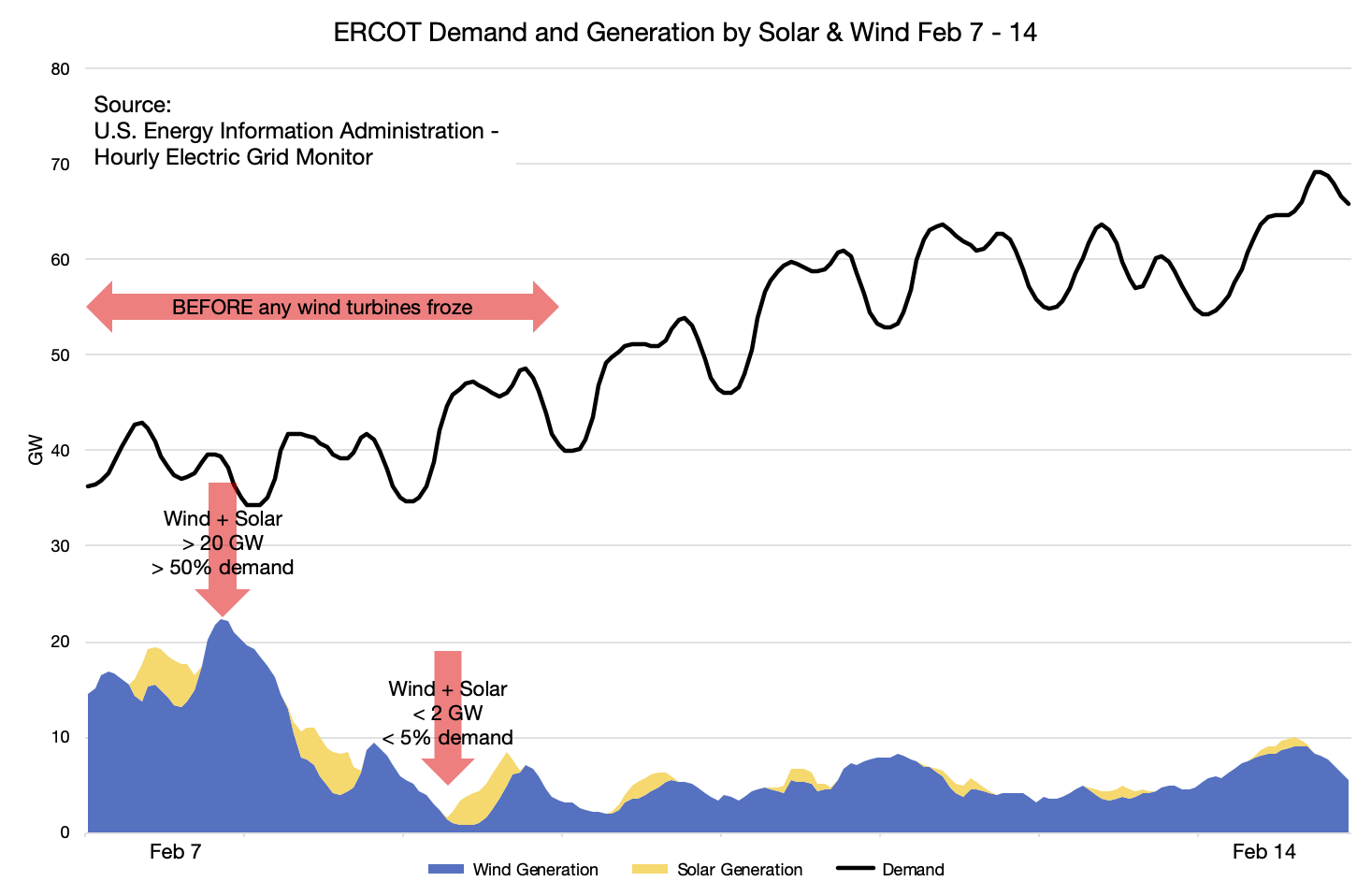
-
Grid operators around the country are warning us that we are retiring too many reliable power plants. MISO—the Midcontinent Independent System Operator—recently released this chart, showing a decline in “accredited capacity” “due to thermal retirements” and increasing solar/wind.3
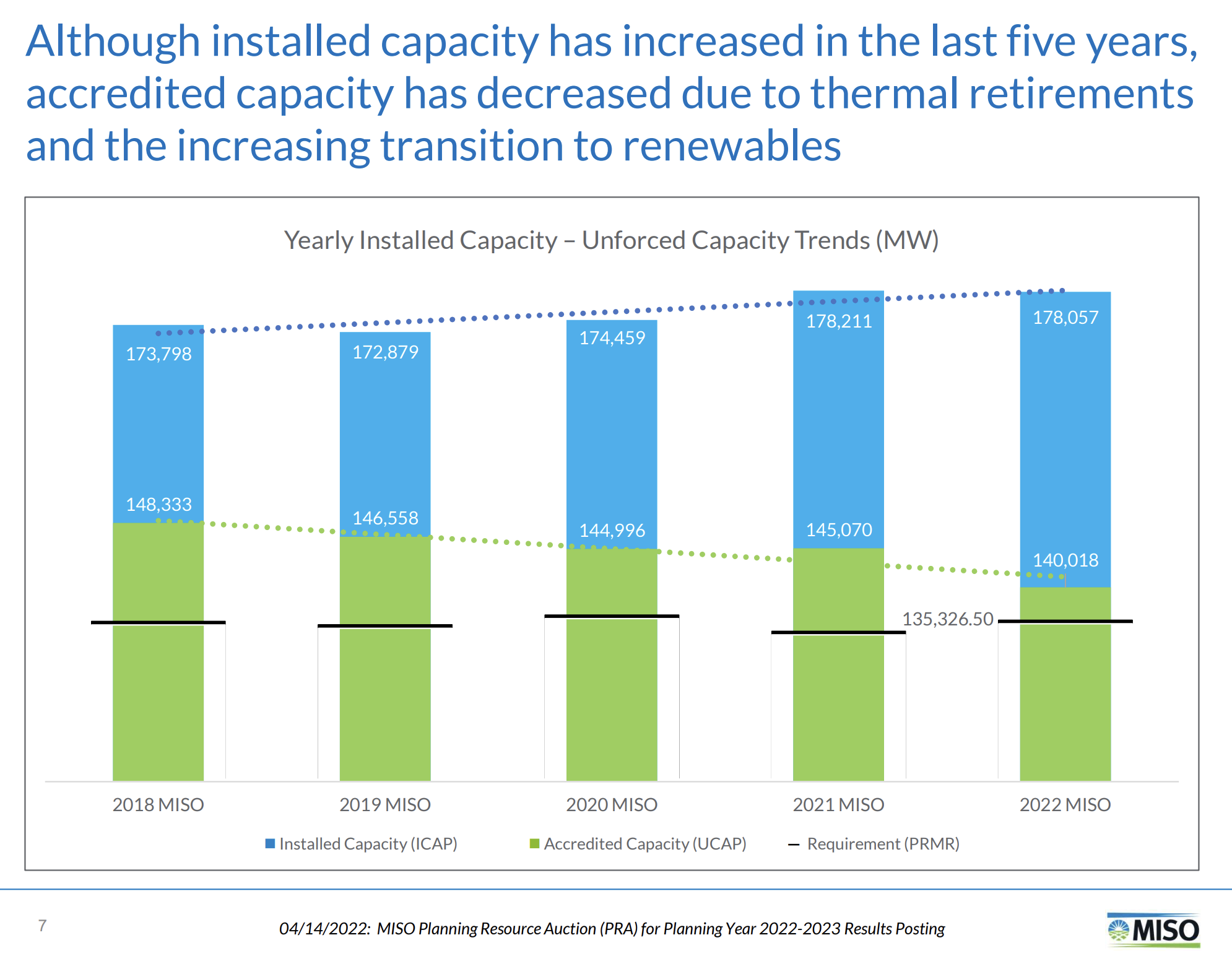
-
Nationally, as demand has increased over the last 10 years we have seen a decline in reliable capacity (gas, coal, oil, nuclear, hydro, battery storage) by 5%.4
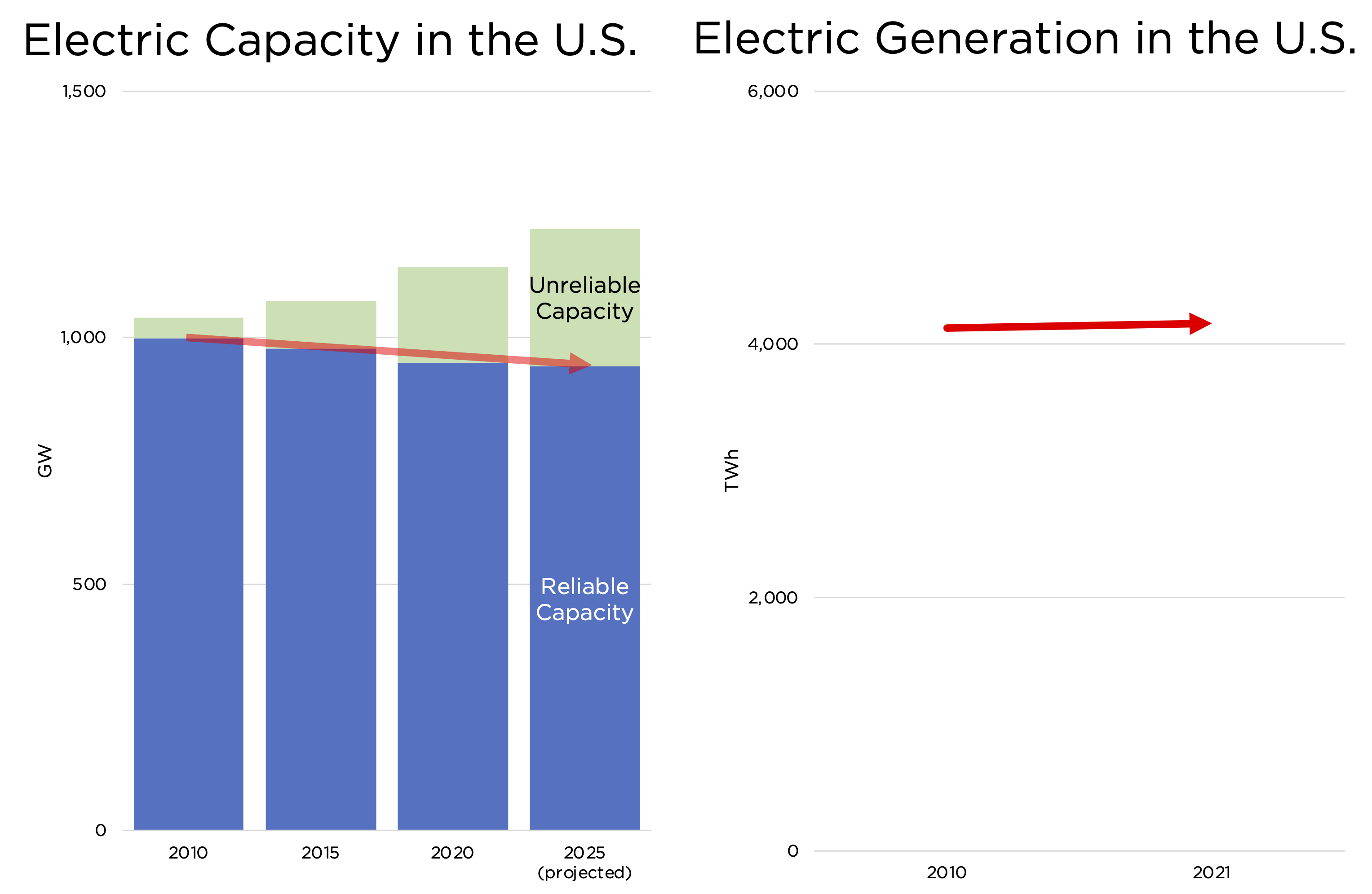
-
Decreasing reliable capacity as demand increases is “reliability chicken”: trying to get away with minimal reliable capacity, then hoping the weather cooperates—not increasing demand by getting too hot or too cold, and not decreasing supply by being too cloudy or too calm.
-
The Feb 2021 blackouts in Texas show how dangerous “reliability chicken” can be. Texas’s grid planners hoped it wouldn’t get very cold and that the wind wouldn’t falter too much so their lack of reliable capacity (and resiliency investment) wouldn’t be exposed. But hoping doesn’t work.5

-
The 2020 blackouts in California also show the danger of “reliability chicken.” California retired lots of in-state reliable electric generation capacity and hoped that favorable weather conditions and other available imports from other states would save them. Again, hoping doesn’t work.6

-
Governments need to recognize the reliability crisis and fight it. Instead, they are planning to make the problem far, far worse via policies that will shut down many more reliable power plants while increasing electricity demand.
-
Our reliability problems are scheduled to get far worse
Looking at the publicly announced plans of utilities, which are largely determined by government policies, we are scheduled to see many more shutdowns of reliable power plants in favor of unreliable solar/wind.
-
This year grid operators planned on retiring about 15 GW of reliable capacity and replacing it with only about 12 GW of reliable generation—which has recently become 10 GW as two nuclear units have been delayed until 2023. Every decline in reliable capacity makes the grid worse.7
-
Will batteries make unreliable solar/wind reliable? No. Battery storage is expensive and can only provide a given "capacity" (e.g., 1 GW) for a few hours, and only then if fully charged. Planned batteries are nowhere near enough to compensate for solar and wind's unreliability.8

-
The next 7.5 years are scheduled to be a bloodbath of reliable capacity retirements. There are 93 GW of announced coal plant retirements, plus up to 92 more GW are at risk retiring early due to new Environmental Protection Agency rules. That's almost ⅕ of our already-scarce reliable capacity shut down.9
-
If coal plants will be replaced by plenty of reliable natural gas plants, that would be one thing. But utilities are not planning nearly enough gas plants to offset the likely shutdown of reliable coal plants.10
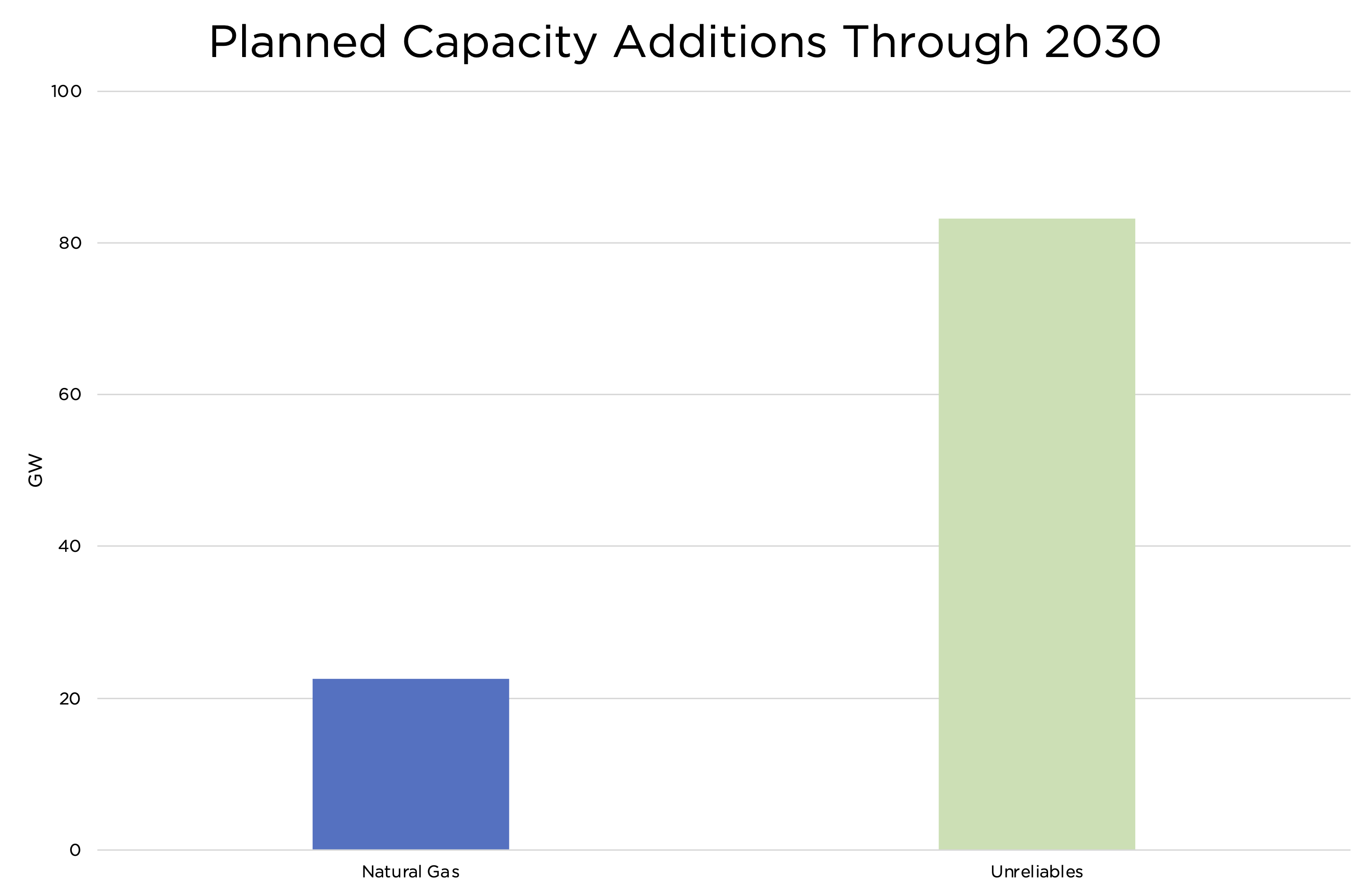
-
Will our rapid shutdown of coal plants that make up ⅕ of our reliable capacity be offset by new nuclear plants? Not remotely. Here are the minuscule plans for nuclear compared to the plans for unreliable solar/wind through 2030.11
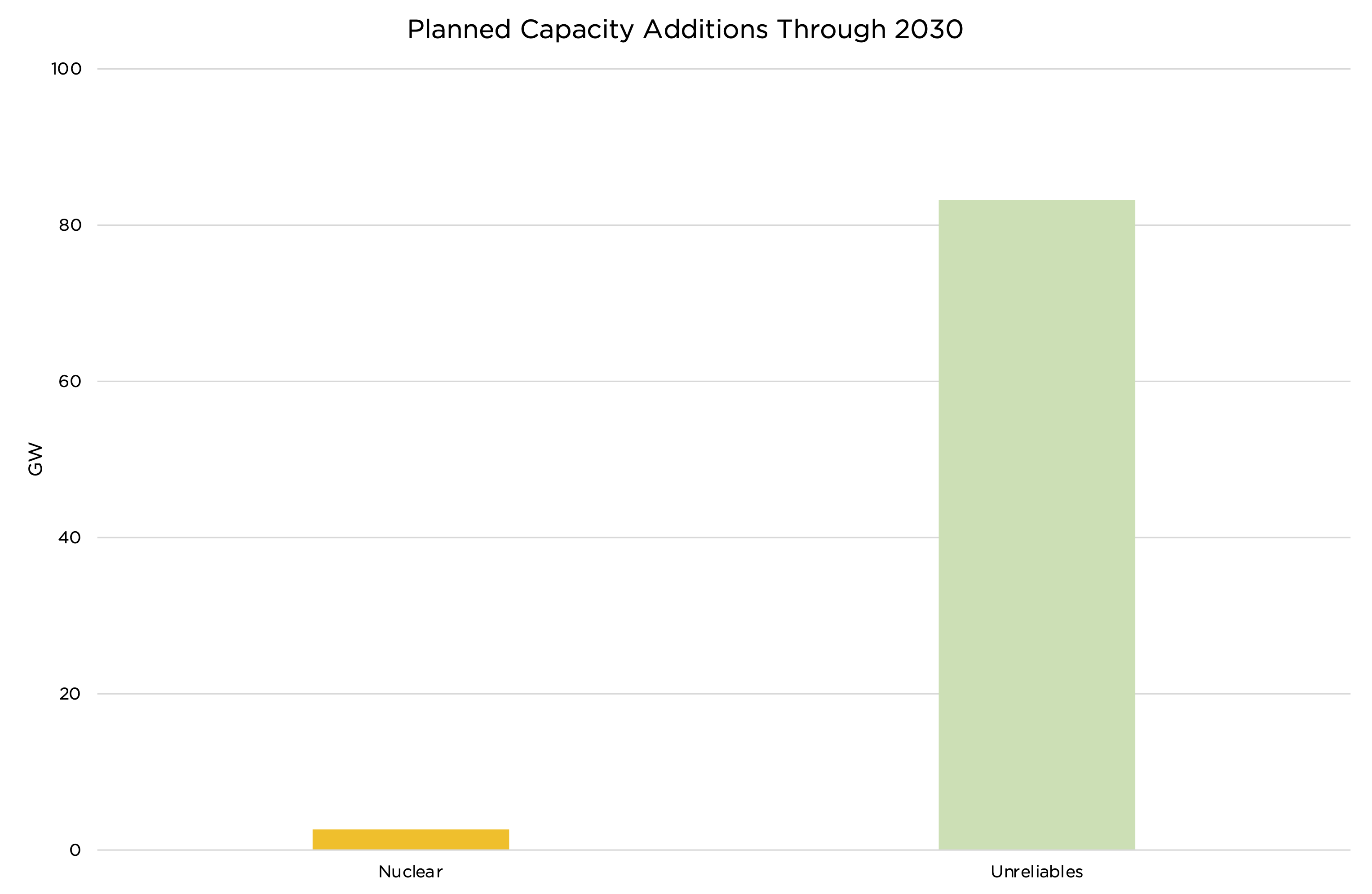
-
To solve the reliability crisis we must understand and reverse the four policies turning America’s grid into a Third-World grid:
- rewarding unreliable electricity
- imposing ruinous Environmental Protection Agency rules on power plants
- criminalizing nuclear
- forcing electric vehicle use
-
Grid-destroying policy 1: Rewarding unreliable electricity
Governments need to stop rewarding unreliable electricity by a) pricing unreliable electricity with no cost penalty, b) subsidizing unreliable generators, and c) mandating significant percentages of unreliables.
-
Stop pricing unreliable electricity with no cost penalty
In every area of life we pay far more for a reliable service than for an unreliable one. But in electricity, unfair rules make utilities pay the same prices for unreliable solar/wind electricity as they do for reliables.
-
Grids need to recognize that unreliable electricity is fundamentally different and far less valuable (sometimes it’s even a burden) than reliable electricity, and pay for unreliable electricity (or not) accordingly.
-
One way to stop vastly overpaying for unreliable electricity is: require all generators to meet certain reliability standards.
Generators would still be able to use solar/wind if they took responsibility for combining it with reliables and/or storage to guarantee reliability.
-
At minimum, grids must stop attributing fantasy reliability to solar and wind—which causes them to vastly overvalue solar and wind and make reckless plans. E.g., a typical grid will treat it as certain that at peak demand 15% of wind and 50% of solar “capacity” will work.12
-
Given the unpredictability of weather and peak demand timing even a month ahead, the effective reliable capacity of solar/wind is near 0. Even if we can expect some wind to blow somewhere in a grid area, it might be much less or more than expected, causing problems either way.
-
Stop subsidizing unreliable generators
Subsidies for unreliable electricity, above all the Investment Tax Credit and the Production Tax Credit, force taxpayers to pay utilities to slow down or shut down reliable power plants whenever the sun shines or the wind blows.
-
Solar/wind subsidies are driving reliable power plants out of business, leading to higher costs and lower reliability.
Ominously, our government recently extended them indefinitely.
A future Congress should end solar/wind subsidies, driving lower prices + higher reliability.13
-
Another form of subsidy to eliminate: subsidizing unreliable solar/wind by socializing their costs, such as additional transmission lines or storage batteries. This subsidy further rewards unreliable electricity at the expense of reliables and of customers.
-
The combination of no penalty for unreliability and special subsidies for unreliables means that instead of unreliables receiving far less money than reliables, they get a huge premium. And more and more reliable power plants go out of business.
-
Stop mandating significant percentages of unreliables
Even beyond paying a premium for unreliable electricity, many states mandate a certain percentage of unreliable solar and wind—and states are becoming more and more aggressive with those mandates. Another dire threat to our grid.
-
Mandates for unreliable solar and wind, which require areas to use solar and wind and shut down reliable fossil fuels and nuclear, regardless of how much costs rise and reliability declines, should be ended wherever they exist.
-
Grid-destroying policy 2: imposing ruinous Environmental Protection Agency rules on power plants
Even though America’s coal plants provide more than ⅕ of our all-too-scarce reliable generating capacity, our government, largely through the EPA, is trying to shut down most or all of these plants in the next 7.5 years.
-
Coal plants today provide 215 GW of reliable capacity—down >100 GW from just 10 yrs ago due to shutdowns.
When plants were at retirement age and replaced more cheaply by gas plants, this made sense. But most coal was retired early, at great cost—and not sufficiently replaced.14
-
We know that the electricity crisis Texas experienced in Feb. 2021 would have been much more widespread had it not been for our fleet of reliable, resilient coal plants. As OK Gov Kevin Stitt explained: “Renewable sources…dropped to almost zero…coal was really bailing us out.”15
-
The Environmental Protection Agency has been the major driving force of cost-adding, reliability-reducing coal shutdowns so far. And it’s the driving reason why between 93-185 GW are expected to retire by 2030–a terrifying 9-18% of our already meager reliable capacity.16
-
The problem with the EPA rules that are shutting down coal plants in catastrophic numbers is that they do not employ genuine cost-benefit analysis. Most egregiously, their analyses of coal shutdowns don’t consider the cost of an unreliable grid!
-
Grid-destroying policy 3: Criminalizing nuclear power
Ultra-promising nuclear energy became ultra-expensive—causing numerous shutdowns of vital plants—in large part because politicians have demonized it and virtually criminalized it through endless unscientific regulations.
-
Nuclear energy, the cleanest and safest form of energy ever devised, has the long-term potential to outcompete fossil fuels at producing electricity and heat, and possibly many forms of transportation, as well.
-
Despite its amazing potential and promising track record, nuclear is stagnating and even declining in much of the world. Costs have increased as much as 10X, in large part because plants that used to take 4 years to build now take 16 years.17
-
And existing nuclear plants are being shut down well before the end of their useful lifetimes. Thankfully, that trend is slowing. But government is doing nothing to address the criminalization that makes new plants virtually impossible to build in any remotely affordable way.
-
By systematically decriminalizing nuclear energy—from eliminating the pseudoscientific ideas that justify it, to vastly speeding up the permitting process, to stopping anti-development activists who delay plants for years—America can lead a new nuclear renaissance.
-
Grid-destroying policy 4: coercing electric vehicle use
At a time when reliable electricity is scarce and about to become far scarcer, the Federal government and certain state governments are trying to force us to use electric vehicles—which would lead to major increases in electricity use at certain times of day.
-
Electric vehicles are a valuable product for certain people but not yet cost-effective for the vast majority of us. The proper electric vehicle policy is to let EVs compete on a free market, but not in any way pressure us to use them before 1) we can afford them and 2) the grid can handle them.
-
Instead of letting electric vehicles compete and facilitating the increase in reliability electricity that large-scale electric vehicle use requires, the Federal and state governments are coercing us into using more EVs while destroying the grid.
-
The most reckless electric vehicle policy of all is California’s, which combines outlawing new oil-fueled vehicles by 2035 and wrecking its grid by shutting down reliable power plants.
As The Babylon Bee put it, “State With No Electricity Orders Everyone To Drive Cars That Run on Electricity.”18
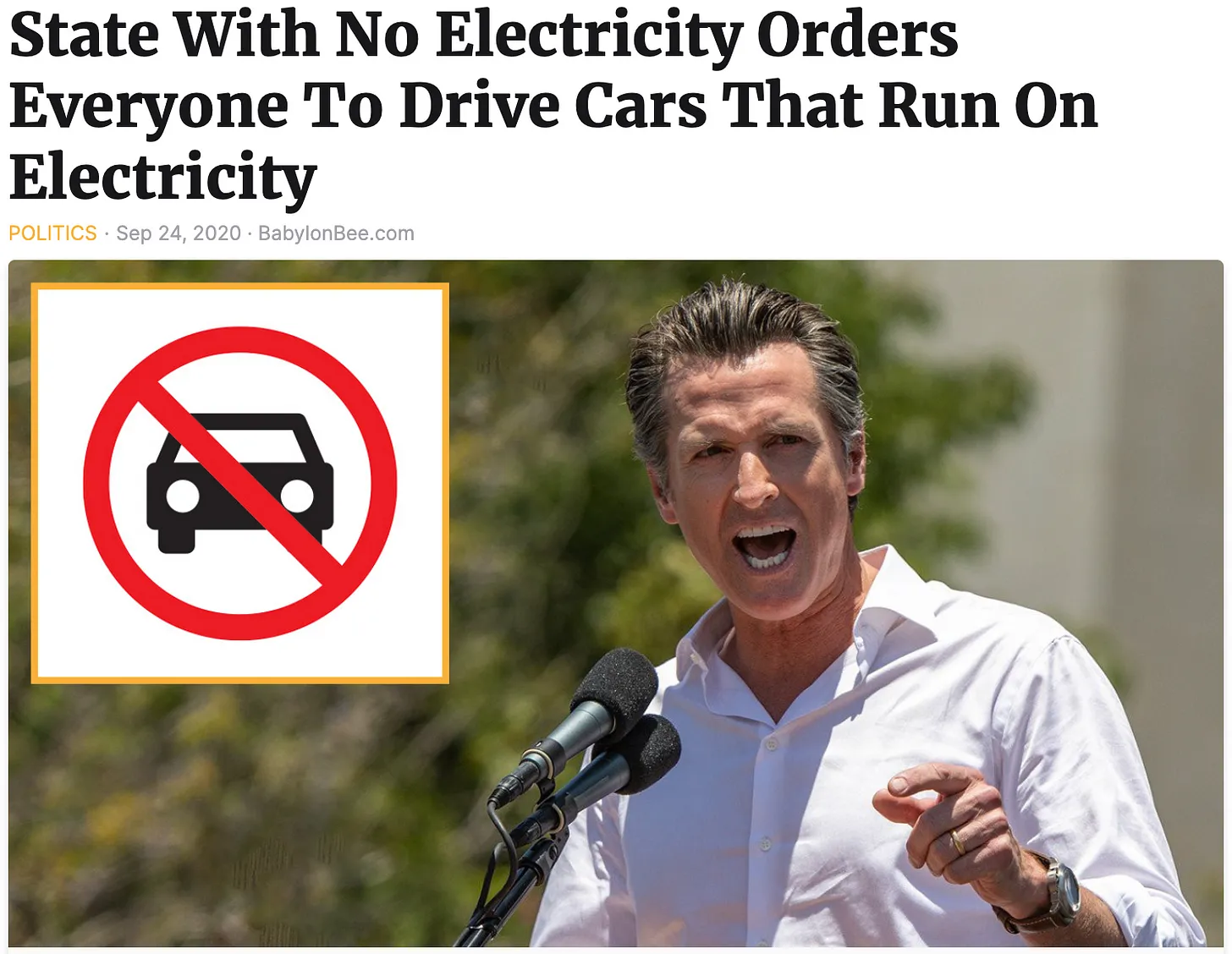
-
California is already having major problems with electric vehicle charging. On August 30, 2022, CAISO, the California grid operator, sent out a press release urging consumers to cut electricity usage during a heatwave, including using less air conditioning (!) and refraining from “charging electric vehicles.”19
-
Note that electric vehicle charging is a threat to the California grid while only a small share of CA’s over 30 million vehicles are electric and solar and wind are only a fraction of what they are supposed become. With less reliable power and far more EVs the situation would be catastrophic.20
-
Imagine if, during the California blackouts of 2020 or the Texas blackouts of 2021 these grids were both far more dependent on unreliable solar+wind and had a massive fleet of electric vehicles that needed charging. Imagine the death toll and economic damage. That’s where our policies are taking us.
-
Electric vehicles should be free to compete on the free market, but should not be forced on us whatsoever. This way, they will proliferate only when 1) we can afford them and 2) the grid can handle them. Instead of being the existential risk to our grid that they are today.
-
Summary: Our grid is disastrously declining thanks to policies that 1) reward unreliable electricity, 2) prematurely shut down coal plants, 3) criminalize nuclear, and 4) force electric vehicle use.
By reversing these policies we can not only avert disaster but make our grid a world leader.
References
- America’s Power - What Others Are Saying About the Potential Reliability Crisis↩
- Alex Epstein - Energy Talking Points on Texas Electricity Crisis
Data from U.S. Energy Information Administration - Hourly Electric Grid Monitor↩ - MISO - 2022/2023 Planning Resource Auction (PRA) Results↩
- U.S. EIA - Electric Power Annual↩
- U.S. EIA - Electric Power Annual↩
- U.S. EIA - Electric Power Annual↩
- U.S EIA - Coal will account for 85% of U.S. electric generating capacity retirements in 2022
U.S. EIA - Solar power will account for nearly half of new U.S. electric generating capacity in 2022↩ - U.S. EIA - Electric Power Monthly↩
- America’s Power - Letter to Mr. James B. Robb, President and CEO North American Electric Reliability Corporation↩
- U.S. EIA - Electric Power Monthly↩
- U.S. EIA - Electric Power Monthly↩
- America’s Power - MISO’S RECENT CAPACITY AUCTION↩
- Foley & Lardner LLP - The Inflation Reduction Act: Key Provisions Regarding the ITC and PTC↩
- U.S. EIA - Electric Power Annual↩
- Count on Coal - DISPATCHABLE FUEL DIVERSITY IS INVALUABLE
Brent Bennett - Forget About What Broke: The Texas Blackout Was Inevitable↩ - America’s Power - Letter to Mr. James B. Robb, President and CEO North American Electric Reliability Corporation↩
- Lovering et al. (2016) - Historical construction costs of global nuclear power reactors
Power Hour - How to liberate nuclear energy, with Robert Zubrin↩ - The Babylon Bee - State With No Electricity Orders Everyone To Drive Cars That Run On Electricity↩
- CAISO - California ISO issues Flex Alert for today, Aug. 31↩
- California Energy Commission - Light-Duty Vehicle Population in California↩